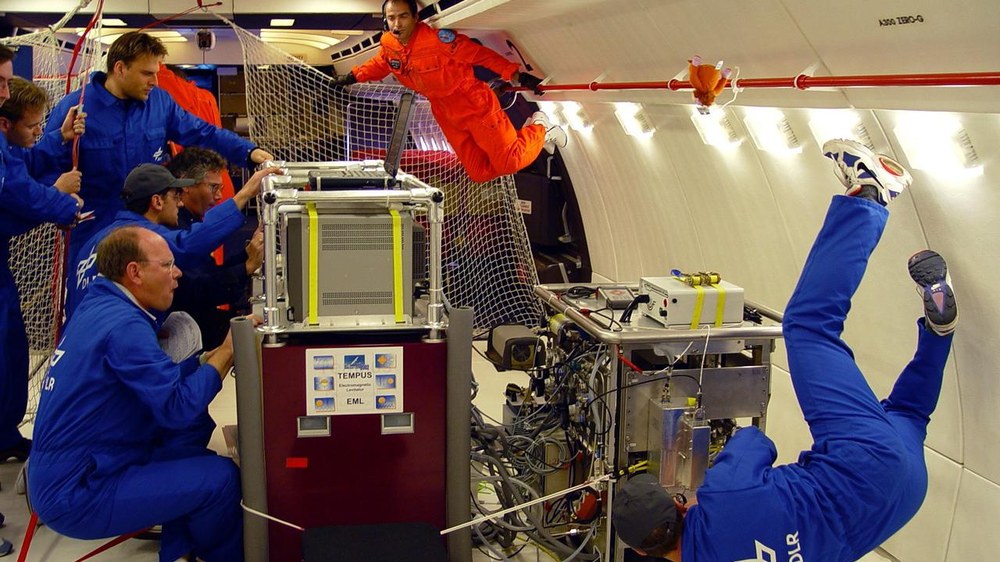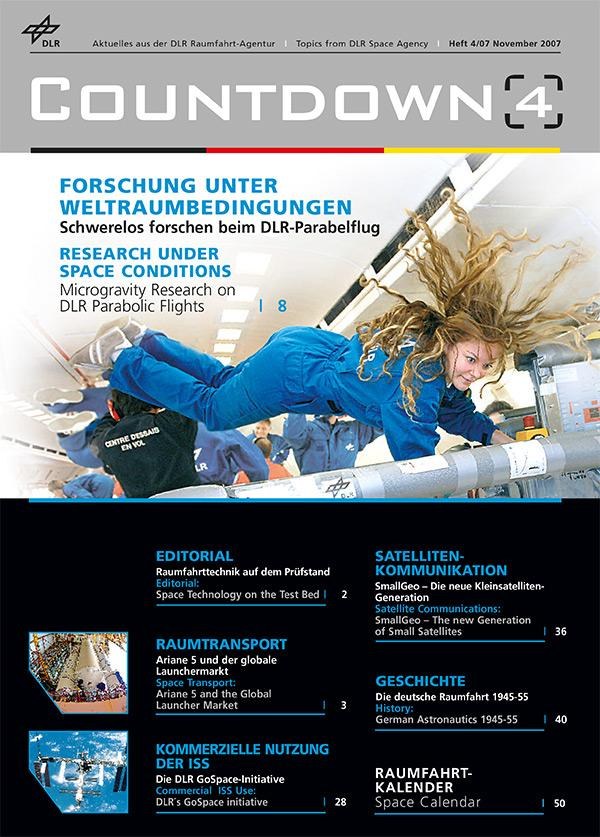Research during a rollercoaster ride in the sky

How do human beings respond to living in weightlessness? How do plants and animals perceive the direction from which gravity acts on them, and what happens when this important parameter is missing from the environment? How can we improve foundry processes? How did Saturn get its rings? Can a satellite antenna be unfolded reliably in weightlessness?
Scientists at the German Aerospace Center (Deutsches Zentrum für Luft- und Raumfahrt; DLR), from universities, Max Planck Institutes, and many other institutions, are trying to answer these and many other questions by conducting experiments during parabolic flights. To create the right conditions for their research, they use the weightlessness that occurs on board of an Airbus A300 ZERO-G during free fall. Specially trained test pilots conduct parabolic flight manoeuvres, during which weightlessness occurs for 20 seconds at the time, up to 31 times per day.
The one or two parabolic flight campaigns conducted annually by DLR have three or four flight days each. About 10 to 20 experiments are carried on board during each 'mission', and up to 35 scientists per flight day. They have assembled their equipment in their own labs, transported it to the Airbus home airport in Bordeaux, and built it into the aircraft. During the flight, they operate and monitor the experiment themselves, and they can adjust parameters if necessary. They are thus able to make optimal use of the in total 30 to 40 minutes of weightlessness.
The flights offer a unique opportunity to explore many different topics under conditions of weightlessness or varying acceleration. Apart from their scientific activities, participants gain experience in project management techniques aimed at meeting deadlines, in international cooperation, as well as in solving technical problems. They explore issues related to security and organisation. Up to 200 people are on site during a parabolic flight. All age groups are represented - from senior high school students, advanced students, doctoral students, and postdocs, to university professors. Physicists, technicians, engineers, biologists, medical experts, psychologists, managers, and journalists all take part. Many teams bring along their partners from international cooperation programmes as well. The participants communicate with each other in German, English, or French. The two weeks of the campaign are very exciting. Checklists need to be worked through, as well as numerous reviews, tests, briefings, and debriefings, and everything needs to be finished "on the dot" on the actual flight day. The working days often last from six in the morning until late at night. All this means that such a research campaign is a truly extraordinary event!
How can students and young researchers working on their final thesis (for Diploma, Bachelor's or Master's degree) or their doctorate participate in a DLR parabolic flight?
If an advanced student chooses a subject in which weightlessness plays a role as an experimental parameter, and if the university in question has teaching staff working on and with weightlessness, this would provide a good starting point for participation in a parabolic flight. Research group leaders develop experiments and submit their experiment proposals to DLR. The DLR Space Agency (DLR Raumfahrt-Agentur) asks for an expert opinion on the proposals and selects the scientific experiments. There are about 12 months between the moment a proposal is submitted and the actual flight.
After the experiment has been assigned to a particular parabolic flight campaign, the scientists prepare the experiment and integrate the required equipment into experiment racks. For young researchers it is often possible to participate in these activities, or even to do part of the work for their final paper by including a parabolic flight experiment. They take part in the team's efforts, assist in the preparations, or even participate in the flight themselves. Human test subjects are often needed for medical experiments. Before, during, and after the parabolic flight they are measured and examined. These test subjects are often students of the medical faculty with which one of the scientific team leaders is associated.
If students who are not yet involved in a research group want to put their own ideas into practice on a parabolic flight, they can apply at the European Space Agency ESA. For further information on the ESA Education Programme, please click the link in the right-hand column.
Can school students also participate in one of DLR's parabolic flights?
In the context of a scientific experiment, even people still at school can occasionally participate in a parabolic flight - as long as they are at least 18 years old. The DLR School Lab in Cologne-Porz works on biological research topics. Specific subquestions can be explored in honours courses at schools in the Cologne and Bonn area in projects lasting several months, and one student from each participating school can take part in the parabolic flight. Some universities occasionally organise special projects in which parabolic flight experiments are worked on and put into practice in close cooperation between schools and scientists. High school students who are dedicated and well-versed in the subject may be allowed to join the flight.
Participating in a scientific parabolic flight is a real challenge. The reward is not just the scientific results which can be obtained, but also a magnificent experience which is quite unlike anything else - at least unlike anything else on Earth! "Real" astronauts say it as well: Long-term or just a few minutes - weightlessness is something unique!


